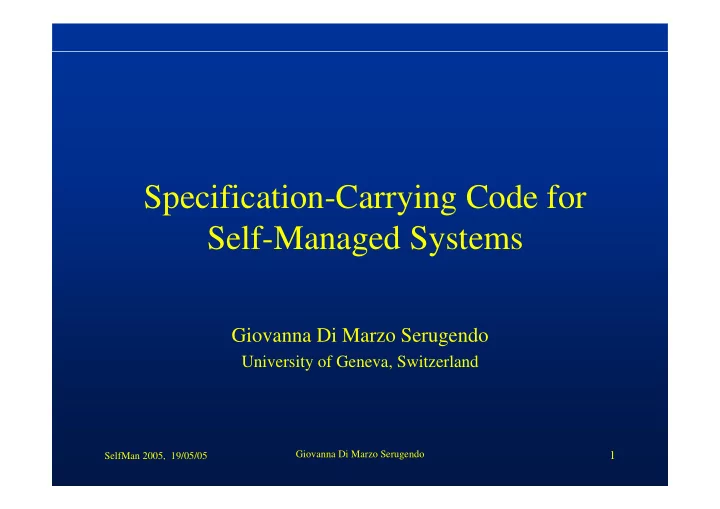

Specification-Carrying Code for Self-Managed Systems Giovanna Di Marzo Serugendo University of Geneva, Switzerland Giovanna Di Marzo Serugendo 1 SelfMan 2005, 19/05/05
Outline • Semantic Infrastructure – « Specification-Carrying Code » (SCC) – Service-oriented architecture • SCC for Autonomic Computing Giovanna Di Marzo Serugendo 2 SelfMan 2005, 19/05/05
Specification-Carrying Code • Idea: communication is based on a formal specification of the behaviour of a peer entity – Software « carries » a formal description of its own functional behaviour – Communication occurs without API – Formal specification defines the semantics of the behaviour Giovanna Di Marzo Serugendo 3 SelfMan 2005, 19/05/05
SCC - Principle Register Σ Σ 1 Σ 2 Code Ax Ax 1 Ax 2 ….. Request Thm Σ Checker Ax { Σ i | Σ i Σ } Giovanna Di Marzo Serugendo 4 SelfMan 2005, 19/05/05
SCC - Architecture RegEx Prolog HOL Register (SpecS,IP,Port) SpecS SpecS,(IP,Port) Search (SpecS) SpecS Service Manager (IP,Port) Execute (ArrayList) CodeWR/SpecE CodeWR/SpecS ArrayList’ Code Code Execute (SpecS) Register Service Entity Giovanna Di Marzo Serugendo 5 SelfMan 2005, 19/05/05
SCC – Prolog • Registration • Request <specs> <specs> <description active="true"> <description active="true"> <content> ReverseList Request <content> Reverse List Service </content> </content> </description> </description> <prolog active="true"> <prolog active="true"> <content> <content> append([],L,L). rev([],[]), rev([A|B],R), rev(B,RevB), append([H|T],L2,[H|L3]):- append(RevB,[A],R), rev(R,[A|B]). append(T,L2,L3). </content> rev([],[]). </prolog> rev([H|T],R) :- rev(T,RevT), </specs> append(RevT,[H],R). </content> </prolog> </specs> Giovanna Di Marzo Serugendo 6 SelfMan 2005, 19/05/05
SCC – Java (no API!) • Registration • Request public class ReverseList extends Service { public class UseReverseList extends Entity { public class static void main(String[] args) private void askForReverseList() { //register reverse list specification // request a reverse list service new ReverseList().register(« localhost », result = Entity.execute(SM_ADDRESS, « specService.xml » ); « specRequest.xml », parameters); } } } public ArrayList execute(ArrayList list) { Collections.reverseList(list); return list; } } Giovanna Di Marzo Serugendo 7 SelfMan 2005, 19/05/05
SCC - Advantages • Interest – Minimum basis for communication • Specification language (for expressing concepts) – Interaction/Interoperability with new/unknown software • No common design / No common API – Self-assembly – Seamless Integration of new entities – Robustness Giovanna Di Marzo Serugendo 8 SelfMan 2005, 19/05/05
SCC for Autonomic Computing • SCC expresses – Functional Behaviour – Non-Functional Aspects • Policies • Trust • Quality of Service – Execution Flow Giovanna Di Marzo Serugendo 9 SelfMan 2005, 19/05/05
SCC for Autonomic Computing • Self-Configuration (installation, configuration, integration) “ Automated configuration of components and systems follow high- level policies. Rest of System adjusts automatically and seamlessly [Kephart03] ” – SCC expresses high-level configuration policies • High-level requests (goals) from human admin (installation needs) • High-level requests for configuration policies (Grid distribution) • Local-level: components express individual installation needs (CPU, memory, etc.) – Unanticipated dynamic run-time evolution of code • Seamless integration of new components • Distribution of application on-the-fly Giovanna Di Marzo Serugendo 10 SelfMan 2005, 19/05/05
SCC for Autonomic Computing • Self-Optimisation (parameters) “ Components and systems continually seek opportunities to improve their own performance and efficiency [Kephart03 ]” – SCC expresses optimisation policies • Parameters description • Permanent optimisation of parameters depending on the context – At each request • SCC Middleware seeks optimised service (most recent, most efficient, etc.) Giovanna Di Marzo Serugendo 11 SelfMan 2005, 19/05/05
SCC for Autonomic Computing • Self-Healing (error detection, diagnostic, repair) “ System automatically detects, diagnoses, and repairs localized software and hardware problems [Kephart05]” – Generation of correct code from SCC – Replace error code with code having matching specification – Checking of code against specification Giovanna Di Marzo Serugendo 12 SelfMan 2005, 19/05/05
SCC for Autonomic Computing • Self-protection (detection and response to attacks) “System automatically defends against malicious attacks or cascading failures. It uses early warning to anticipate and prevent systemwide failures [Kephart05]” – SCC expresses high-level security policies • Conditions regulating services delivery • Signatures of attacks / Response schema – Self-regulating schema • Trust and reputation information Giovanna Di Marzo Serugendo 13 SelfMan 2005, 19/05/05
Conclusion • SCC – Specifications of behaviour – Implementation through a middleware infrastructure – Interoperability solution – No need for compatible interfaces • SCC for Self-Managed Systems – Functional properties – Non-functional properties – Run-time (re)configuration policies/schemas – Run-time description of interaction protocols Giovanna Di Marzo Serugendo 14 SelfMan 2005, 19/05/05
Recommend
More recommend